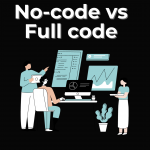In 2023, building an app without coding has become a reality, thanks to the rise of no-code development platforms. These platforms empower individuals, startups, and businesses to create functional and polished applications without the need for traditional coding skills. The process begins with choosing the right no-code platform that aligns with your project’s goals and requirements. Once selected, you can embark on designing the app’s user interface, utilizing intuitive drag-and-drop tools to craft a visually appealing and user-friendly layout.
Adding functionality to your app is a breeze with no-code platforms, as they offer pre-built components and templates for common features like forms, databases, and user authentication. Configuring the logic and behavior of your app is equally accessible, thanks to visual workflows and logic builders provided by these platforms. The iterative nature of no-code development encourages extensive testing, allowing developers to identify and resolve issues quickly.
When the app is ready for deployment, it can be published on app stores or as web applications. Continuous improvement is facilitated by gathering user feedback and implementing updates in real-time. As your app gains traction and users, you can scale it by incorporating additional features and functionality. The advent of no-code development in 2023 democratizes app creation, making it accessible to a broader audience, and reshaping the landscape of software development.
Why Consider No-Code App Development?
Traditionally, developing an app required proficiency in programming languages, such as JavaScript, Python, or Java. This posed a significant barrier for entrepreneurs, small businesses, and individuals with innovative ideas but limited coding skills. No-code development bridges this gap by offering intuitive, visual interfaces that simplify the app-building process. Here are some compelling reasons to consider no-code development:
Accessibility:
No-code platforms are designed for everyone, regardless of their technical background. This inclusivity empowers a broader range of individuals to participate in app development.Cost-Efficiency:
Building an app without coding can be more cost-effective than hiring developers for custom coding. It reduces development time and lowers labour costs, making it ideal for startups and small businesses.Rapid Prototyping:
No-code platforms are perfect for creating prototypes and Minimum Viable Products (MVPs). They enable entrepreneurs and startups to test their ideas and gather user feedback before investing in full-scale development.Empowerment:
No-code development empowers non-technical individuals, such as business analysts, marketers, and domain experts, to create custom software solutions tailored to their specific needs. This reduces reliance on IT departments and accelerates project delivery.Innovation:
No-code platforms foster innovation by enabling creative problem-solving and experimentation. Users can quickly build and test new ideas, driving continuous improvement.User-Centric Design:
No-code platforms emphasize user-centric design, allowing creators to focus on delivering seamless, user-friendly experiences.Time Efficiency:
No-code development significantly reduces the time required to go from concept to a functional app, allowing businesses to respond rapidly to changing market conditions or emerging opportunities.
How to Build an App Without Coding in 2023
In 2023, building an app without coding has become increasingly feasible, thanks to the emergence of low-code and no-code development platforms. These platforms empower individuals, including those without extensive programming experience, to create their own applications. With intuitive visual interfaces and pre-built components, app development has become more accessible and efficient. Users can conceptualize, design, add functionality, integrate data, test, and even publish their apps without writing a single line of code. This democratisation of app development allows a wider range of people to bring their unique ideas to life and participate in the ever-evolving digital landscape.
Define Your App Idea
Start by defining your app’s purpose and target audience. What problem does it solve, and who will benefit from it? Having a clear vision is crucial.
Choose a No-Code Development Platform
Research and select a suitable no-code platform based on your app’s requirements. Popular options like Bubble, Adalo, and OutSystems offer different features and capabilities, so choose one that aligns with your project.
Design Your App’s UI
Use the platform’s visual interface to design your app’s user interface (UI). These platforms provide drag-and-drop tools for creating layouts, adding buttons, images, and customizing the overall look and feel of your app.
Add Functionality
No-code platforms offer a plethora of pre-built components and templates that cover a wide range of functionalities. You can easily integrate features like user authentication, databases, forms, and payment processing without writing code.
Configure Logic
Define how your app behaves using visual workflows and logic builders provided by the no-code platform. Set up interactions, data flow, and conditional actions through intuitive interfaces, eliminating the need for coding.
Test and Iterate
Thoroughly test your app to identify any issues or bugs. No-code platforms support rapid iteration, allowing you to refine your app based on user feedback and evolving requirements.
Publish Your App
Once your app is ready, you can publish it as a web application or, in some cases, submit it to app stores depending on your target platform and audience.
Gather User Feedback
Encourage users to provide feedback and closely monitor their interactions with your app. Use this valuable feedback to make continuous improvements and updates.
Scale Your App
As your app gains traction and user engagement increases, consider scaling it further. You can add more features, optimize performance, and expand your user base.
Stay Informed
The no-code landscape is continuously evolving. Stay informed about the latest developments in the industry, as new tools and features are regularly introduced, offering even more possibilities for app creators.
The Benefits of No-Code App Development
Building an app without coding is a game-changer, empowering entrepreneurs, small businesses, and creative individuals to bring their app ideas to life without the traditional barriers of coding expertise. Here are some more advantages of no-code development:
Rapid Application Development
No-code tools significantly expedite the development process. Traditional coding can be time-consuming and complex, requiring a skilled development team to write and debug code. In contrast, no-code platforms streamline this by providing a visual interface that simplifies the application design process. Creators can drag and drop pre-built components, set parameters, and configure workflows without delving into the intricacies of coding. This agility is particularly valuable when businesses need to respond quickly to market changes or seize emerging opportunities. It allows them to swiftly develop and deploy applications, gaining a competitive edge.
Empowering Non-Developers
No-code platforms empower individuals with diverse backgrounds and expertise, enabling them to participate in application development. Non-technical users, such as business analysts, marketers, and domain experts, can take an active role in creating software solutions tailored to their unique needs. This democratization of development reduces the reliance on IT departments and accelerates project delivery. It fosters collaboration across departments, ensuring that the software aligns closely with business objectives.
Rapid Prototyping
No-code platforms are ideal for creating prototypes and Minimum Viable Products (MVPs). They provide an environment where entrepreneurs and startups can translate their ideas into functional prototypes swiftly. This allows them to validate concepts, gather user feedback, and refine their product offerings before committing to full-scale development. It’s a cost-effective way to test the viability of a product and make informed decisions based on real-world usage data.
User-Centric Design
No-code platforms prioritize user-centric design principles. They offer user-friendly interfaces and intuitive tools for designing applications. Creators can focus on delivering seamless, engaging user experiences without being bogged down by the technical intricacies of coding. This approach not only reduces the learning curve but also ensures that the end product is more likely to meet user expectations. It promotes higher user satisfaction, leading to increased adoption and success in the market.
User Feedback Integration
No-code development facilitates the integration of user feedback into the development process. With the ability to quickly make changes and updates to the application, creators can respond promptly to user suggestions and pain points. This agile approach to development ensures that the software remains aligned with evolving user needs and preferences, contributing to its long-term relevance and success.
Reduced Development Costs
Building software with no-code platforms can be more cost-effective than traditional coding. Traditional development often involves hiring skilled developers, which can be expensive. No-code platforms reduce the need for extensive coding expertise, saving on labor costs. Additionally, the rapid development and deployment cycles mean less time and resources are spent on the project, further reducing costs.
Innovation and Experimentation
No-code platforms encourage innovation by enabling creative problem-solving and experimentation. Creators can quickly translate their innovative ideas into functional prototypes or applications without being limited by coding constraints. This freedom to experiment fosters a culture of innovation within organizations, where employees are encouraged to explore new solutions and drive continuous improvement.
Embrace No-Code App Development Freedom
In conclusion, building an app without coding in 2023 has become more accessible and efficient thanks to the rise of no-code development platforms. These platforms offer a wide range of benefits, including rapid application development, empowerment of non-developers, cost-effective solutions, and a strong focus on user-centric design. GeekyAnts is a cutting-edge low-code platform that empowers businesses and developers to create robust applications quickly and efficiently. No-code tools enable individuals and businesses to turn their app ideas into reality, from rapid prototyping to user feedback integration and reduced development costs. They foster a culture of innovation and experimentation, allowing creative problem-solving without the need for extensive coding expertise.
As the no-code landscape continues to evolve, staying informed about the latest developments and tools is essential for anyone interested in app development. With the right no-code platform and a clear vision, you can bring your app concept to life, test it in the real world, and iterate based on user feedback. Whether you’re an entrepreneur, a startup founder, or a business professional looking to create software solutions, the no-code revolution in 2023 provides the tools and opportunities to turn your ideas into functional applications. It’s an exciting era for app development, where innovation is at the forefront, and traditional coding is no longer a barrier to entry.





















